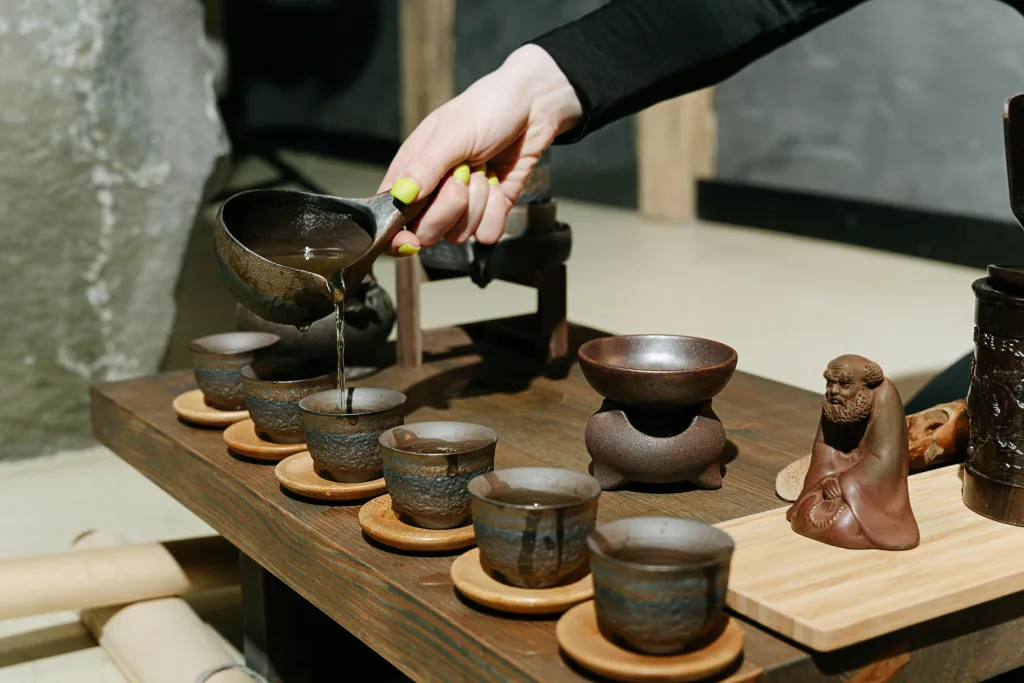Tea is not only about the leaves or the water—it is also about the tools that bring out the best flavors and experiences. The art of tea is deeply connected to the use of appropriate tea wares, which enhance the beauty and taste of tea. In this guide, we will explore various types of tea wares and how to use them to make your tea experience both traditional and delightful.
1. Yixing Clay Teapot (紫砂壶)
The Yixing clay teapot, made from the unique purple clay (zisha) of Jiangsu Province in China, is highly prized among tea enthusiasts. The porous nature of Yixing clay allows it to absorb the flavor and aroma of tea, enriching future brews. It is ideal for brewing oolong, black, or pu-erh tea, as these teas benefit from high heat retention and the ability to “season” the pot over time. One crucial rule when using a Yixing teapot is to dedicate it to a single type of tea to avoid mixing flavors.
2. Gaiwan (盖碗)
The gaiwan is a lidded bowl consisting of three parts: a saucer, a bowl, and a lid. It is a versatile tool for brewing almost any type of tea, especially green, white, and light oolong teas. Using a gaiwan allows for full control over the brewing process, as you can easily adjust steeping times and temperature by manipulating the lid. It requires a bit of practice, as pouring from a gaiwan can be tricky, but once mastered, it provides a pure and clear tasting experience.
3. Glass Teapot (玻璃茶壶)
A glass teapot is perfect for brewing teas with beautiful appearances, such as flowering teas or green teas with delicate leaves. The transparent nature of the teapot allows you to watch the tea leaves unfurl gracefully, adding an element of visual enjoyment to the tea experience. Glass teapots are non-porous and do not retain flavors, making them suitable for brewing various types of tea without cross-flavoring. However, they are fragile and do not retain heat as well as Yixing or ceramic teapots.
4. Cast Iron Teapot (铁壶)
Originating in Japan, cast iron teapots (tetsubin) are known for their excellent heat retention. These teapots are often lined with enamel to prevent rust, making them suitable for brewing a wide variety of teas, especially robust teas like black and roasted oolongs. The heat retention capabilities of cast iron make it ideal for keeping tea warm for longer periods, allowing you to enjoy multiple servings without losing flavor. However, due to their weight, they can be cumbersome to handle.
5. Porcelain Teapot (瓷茶壶)
Porcelain teapots are lightweight, elegant, and often beautifully decorated. They are perfect for brewing delicate teas such as green and white teas, as they do not absorb flavors and provide a neutral brewing vessel. The smooth, non-porous surface of porcelain ensures that the taste of each tea is pure and unaltered. They also come in a variety of sizes, making them a great choice for both individual servings and group settings.
6. Tea Strainer (茶滤)
A tea strainer is an essential tool for loose-leaf tea brewing. It can be used to filter the leaves when pouring tea from a teapot into a cup, ensuring a clear, debris-free brew. Tea strainers are especially useful when using teapots without built-in strainers. They can be made from metal, bamboo, or even porcelain, adding a touch of tradition or elegance to your tea set.
7. Cha Hai (茶海) or Fairness Pitcher
A cha hai, also known as a “fairness pitcher,” is used to ensure that the tea poured into each cup has a consistent flavor. After brewing tea in a gaiwan or teapot, the tea is poured into the cha hai before being served to individual cups. This step prevents the tea from becoming over-steeped and ensures that each guest receives tea of the same strength. The cha hai is especially useful for oolong and puerh tea ceremonies.
8. Tea Tray (茶盘)
A tea tray is used to catch spills during the tea-making process, especially during gongfu tea ceremonies. The tray often has a drainage system to collect excess water, which makes the brewing process cleaner and more organized. Tea trays come in various sizes and materials, including bamboo, wood, and ceramic, and they help create an elegant presentation for your tea session.
Choosing the Right Tea Ware
The right tea ware depends on the type of tea you are brewing and the kind of experience you wish to have. For a visual and fragrant experience, a glass teapot is perfect for showcasing blooming teas. For a more traditional and ritualistic tea session, the Yixing teapot or gaiwan offers an authentic touch. Cast iron teapots are ideal for maintaining warmth, while porcelain teapots provide a neutral vessel for delicate teas.
By understanding and selecting the appropriate tea ware, you can elevate the entire tea experience—from the aroma and taste to the aesthetic pleasure. Whether you are hosting a tea ceremony or simply enjoying a quiet cup at home, the right tools can bring out the best in your tea and help you connect deeply with this ancient tradition.
